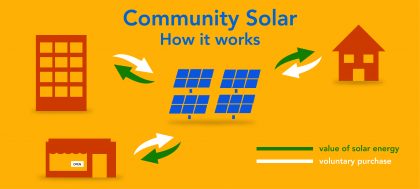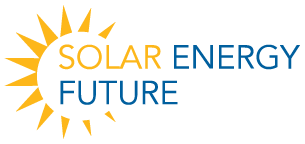How does solar power homes, apartments, and offices?
Solar technologies harness the heat and light of the sun and convert it to electricity for consumers. Solar panels are a common type of solar technology. The panels that generate this power can be located on rooftops or ground-mounted arrays close to the consumer. This is known as distributed generation. Solar panels are also utilized by large power plants that supply electricity to large populations or entire municipalities. These panels are built at utility-scale.
Please follow these links for more information:
Do solar panels work when the sun is not shinning?
Solar panels work most efficiently in direct sunlight, but can also generate power when in indirect sunlight. Therefore, solar panels will still work when sunlight is partially blocked by clouds. Some utility- scale power plants have the ability to store energy when the sun is shining, and then use it when the sun sets or during inclement weather. Even if clouds reduce solar panel efficiency, they are still effective, making solar a good match for even cloudy locations.
Please follow these links for more information:
Can I afford to install solar panels?
Yes! Of course, every property is different, and the cost of installing depends on a few factors, such as labor costs, competition, incentives, and permitting costs.
Solar is also becoming increasingly affordable. One reason is that the US has several incentive programs at the local, state, and national level that make solar more affordable. Additionally, solar power is following the general technology trend of getting less expensive as it is more widely adopted. And, as more solar companies enter the market place, they compete with one another, further driving down the cost of solar.
Please follow these links for more information:
How does a solar lease work? How is it different from a Solar Power Purchase Agreement?
A solar lease is a tool to finance your transition to solar. With a solar lease, a third part installs a solar system on a property owner’s property and the property owner pays the third party for the system over a period of time. Here, the property owner is paying for the actual solar system, not just the power generated by the system.
With a solar power-purchase agreement, a property owner allows a third party to install a solar system on his or her property at no cost. The property owner then pays the third party a pre-set fee for the power generated by the system each month. This price is set, for example, at 15% lower than the property owner’s highest utility rate absent the solar system. For the property owner, the lease allows them access to solar electricity without a large upfront cost for installation.
Please follow these links for more information:
What is a SREC?
A “SREC” is a Solar Renewable Energy Credit. One SREC is generated when one megawatt-hour (MWH) of soar- generated electricity is produced. These credits are typically used in conjunction with a Renewable Portfolio Standard (RPS). A RPS is a form of legislation requiring energy suppliers to produce a certain percentage of their electricity from renewable energy sources such as sunlight.
In a state that has a RPS, energy suppliers must develop their own renewable energy facilities such as solar plants to produce SRECs, or purchase SRECs from others that own renewable energy facilities, to avoid paying a fine. This fine is called an Alternative Compliance Payment (ACP).
More than half of all U.S. states have some type of renewable energy standard or goal in place. National RES policies have been considered by Congress but have not been signed into law.
Please follow these links for more information:
Are there tax credits available for installing solar panels?
There are a variety of financial incentives for installing solar panels including. For example, the federal investment tax credit (ITC) is a 30 percent tax credit for solar systems on residential and commercial properties. The tax credit is either applied by the company that installs, develops, or finances the project on a property or by a homeowner who purchases and installs the system on his or her property. In both scenarios, the credit is equal to 30 percent of the basis that is invested in the solar system. In addition to federal tax credits, states and local governments offer other subsidies for solar power investment such as grants, low-interest loan programs, property tax reductions, and sales tax exclusions.
Please follow these links for more information:
Do companies use solar panels?
Business facilities, commercial and industrial buildings, and utilities use solar panels. For large-scale generation, hundreds of solar panels are interconnected to form a large utility-scale solar system that then distributes solar energy to customers through the grid.
Please follow these links for more information:
How many solar panels does it take to power my home?
A typical home will use about 10 to 20 solar panels to power the home. The most common home solar electric system utilizes panels that are fixed in place (usually on roofs). The number of panels needed to power a home depends on a variety of factors such as the home’s electricity consumption, whether the homeowner wants the solar system to generate all of the home’s electricity, or a certain percentage, and whether the home utilizes a stand-alone solar system or a grid-connected system.
Solar panels can power multiple homes by being connected to the electric grid. With a grid-connected solar electricity system, when the system produces excess power, the electricity is fed back into the grid. Most states allow for a process where the excess electricity generated “turns back” the owner’s electricity meter. If the owner uses more electricity than their system feeds into the grid, they pay the power provider only for the difference between what they used and what they produced. This is known as net metering.
Solar panels range in size and use. In addition to residential homes utilizing small rooftop systems, commercial and industrial buildings use solar panels as well. Even municipalities and large utility-scale plants use solar power.
Solar panels can power multiple homes by being connected to the electric grid. With a grid-connected solar electricity system, when the system produces excess power, the electricity is fed back into the grid. Most states allow for a process where the excess electricity generated “turns back” the owner’s electricity meter. If the owner uses more electricity than their system feeds into the grid, they pay the power provider only for the difference between what they used and what they produced. This is known as net metering. Here, one owner’s solar panels can be used to generate electricity for other users connected to the grid.
Solar panels can also power multiple homes with Community Shared Solar Energy Systems. Here, community members come together to purchase a collective system and each owner gets a share of the power generated by the system.
 Please follow these links for more information:
Please follow these links for more information:
How can I determine if solar is right for me?
To determine if solar is right for you, you might want to consider: Do you want to lease or own a solar system? Do you have clear and unobstructed access to sunlight for most of the day and throughout the year? Do you have the space to accommodate a solar system? Are there any local permits or covenants that could inhibit your ability to install and utilize a solar system? What is the cost of installing and maintaining the system and are there any tax credits available?
Please follow these links for more information:
Are you interested in installing solar panels?
If you are interested in installing solar panels in your home, business, or even apartment the following links will help you determine whether solar is right for you, and how to implement it if it is.
Please follow these links to for more information:
Want to learn more about solar?
Electricity generated through solar power is a low-carbon method of producing energy with large scale potential. Of its several benefits, the most notable is that it is both clean and renewable. Even concerns with high prices are being mitigated with the advent of new business models that are allowing the technology to expand.
Yet, solar power requires more advances in science and technology to reduce the price to the point that wide spread proliferation can take place. Several new and unique technologies under development will help with this process and should competitively position it to support long-term growth.
Please follow these links to see recent studies and resources on the future of solar power:
- Incentivizing Solar Energy: An In-Depth Analysis of U.S. Solar Incentives
- Solar Evolution and and Diffusion Studies
- Solar Cost-Benefit Studies
- Solar Energy Resource Center
- Nevada Solar Incentive Impact Study
- MIT Future of Solar
- Top Solar Power Industry Trends for 2015
- HBS: “Power from Sunshine”: A Business History of Solar Energy
- Planning for Solar Energy Briefing Papers

